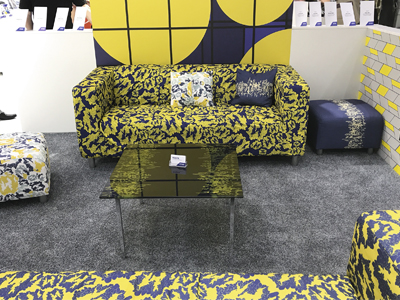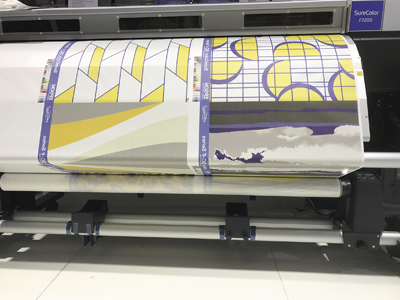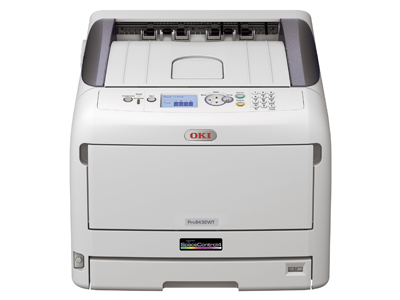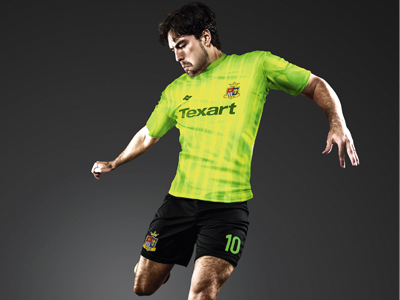Roland has developed yellow and pink fluorescent inks for its Texart dye sublimation printers
Most décor printing relies on dye sublimation printing but the printer is only part of the equation. Nessan Cleary looks at the materials side of the equation.
It is a basic fact of life that a mug of tea will taste the same from a plain white mug as it will from one with a picture, even if the picture shows your nearest and dearest. But most of us still prefer to use the mug with the graphic even though it will cost a bit more. This applies equally to plenty of other products from smartphone covers to t-shirts and curtains and is the essence of decorative printing. Some people will argue that this is really two markets: textiles, meaning things like curtains, cushions and t-shirts; and other objects, such as mugs, coasters and chopping boards. But just to confuse matters, many people also talk about a furnishings market, which includes a little of both, as well as wallpaper and flooring.
Regardless, the basic technology for printing all these different products is dye sublimation, which works with polyester fabrics and blank objects that have been coated with a polyester layer. This involves printing the graphic to a transfer paper and then clamping the paper to the final product in a heat press and heating it to 180 to 200°C, which releases the ink from the paper, and drives it into the fibres of the polyester. This results in a graphic that is embedded within the item and is extremely resistant to rubbing or repeated washing.

These printed furnishings, produced by students at Birmingham City, give an idea of the range of furnishings that printers could offer, including sofa covers and cushions
Transfer window
One of the most important factors in this is the transfer paper. Brett Platt, textile product manager for Hybrid Services, explains that there are different types of paper, adding, ‘The heavier the paper, the more ink it can carry so if you print to a heavy fabric and you need to put a lot of ink down then you print to a heavier paper. You want to find a balance between paying as little as you can for the paper and getting the maximum amount of ink in the fabric.’
There are a lot of different papers available, with many dealers selling their own brand, but there are three major suppliers worldwide. Coldenhove Papier, based in Holland, set up its first paper mill in 1661 and moved into digital dye sublimation transfer papers in 1998 with the development of the Jetcol range. This is a coated sublimation paper that can offer high yields up to 97%. It’s available in different weights, from lightweight to the standard 95gsm, up to the 140gsm HTR4000.
Coldenhove also makes the Digicol range of décor papers, for applications such as kitchen furniture. The papers can be printed with water-based or UV inks and then laminated or dry-pressed to the final substrate. The range includes the entry-level D500, which has no opacity and can be dry-laminated, the D1500, which has good resin absorption and fibre saturation with some opaqueness, and the more expensive D2000, which has an additional coating to hold sharp details and better colour density.
The Cham Paper Group is headquartered in Switzerland but also has production sites in Italy. It produces substrates for large format printing, including the Transjet series for sublimation. This includes Transjet Fashion, a 45gsm paper designed for use with Kyocera printheads and available in widths up to 3.2m. Other papers range from 70gsm through to 130gsm, and are aimed at a mixture of printers, including those from Epson, Mimaki, Mutoh and Roland, as well as more industrial machines from MS Italy and EFI Reggiani. They cover applications from curtains and table cloths through to ceramics, snowboards and skis as well as sportswear, flags and banners.
The American company Beaver Paper is based in Atlanta, Georgia with sales and distribution arms in California and Holland. The company produces its TexPrint transfer papers for small, wide and grand format printers. There are different weights, from 58 through to 140gsm for large format printing. Amongst these is TexPrint XPHR, which can be used for both hard and soft substrates, including ceramics, metals and glass. It’s sold in 105 and 140 gsm weights.
As well as papers, the company has also branched out into producing printable fabrics, mainly for soft signage. The range includes knit and woven materials, which are mostly 100% polyester. They are compatible with sublimation transfer, disperse direct, latex, UV curable and solvent printing processes.
Naturally, most of the printer vendors also sell their own range of transfer papers, which will have been tested to work for their printers and come complete with any necessary colour profiles.
Sublimation inks
The other side of the equation are the dye sublimation inks. These are water-based and can offer a very wide colour gamut with just the four process CMYK colours. Some vendors also include fluorescent colours, mainly for sportswear. In the past people would have converted an existing roll-fed printer for textile use by changing the inks for a specialist third party dye sublimation inkset. But nowadays there’s a good choice of dye sublimation printers that come complete with the manufacturers’ own branded inks. There is still a wide choice of third party inks available, some of which also form the basis of the OEM inks.

Wallpaper being printed on an Epson Surecolor F7200 wide format dye sublimation printer
Sun Chemical, for example, supplies inks to printer vendors but also sells its own brand. It has targeted the décor market with its SunTex range, which includes dye sublimation inks for direct or transfer print, pigment based inks and reactive dye inks. Thus, for example, SunTex Sonata DDE inks are designed to work with printers fitted with Epson heads, which includes many Mimaki, Mutoh and Roland printers. This ink can be used for signage, flags, interior decoration and sportswear. It’s supplied in one litre bottles with CMYK plus light cyan and light magenta and is said to offer high ink penetration which would allow for images to show through flags and banners as if printed on both sides.
Another example is the Korean ink company Inktec, responsible for the Jetrix range of wide format printers, which has developed several third party inksets for use with different printers. This includes the SubliNova series of dye sublimation inks. SubliNova Smart can be used direct to fabrics as well as through transfer paper, while SubliNova Sure is a high density ink that should deliver low ink consumption via Epson TFP heads. There’s also SubliNova R-TS, designed for printers fitted with Ricoh Gen5 printheads and suitable for papers up to 70gsm, and variants for use with Epson DX5 and DX7 printheads.
Inktec also sells its own transfer paper, called ITP-HTP. This is a resin coated 100gsm transfer paper available in widths from 900mm to 1.6m and with a matte finish. It’s suitable for applications including soft signage, apparel and décor.
Printable items
There is an enormous range of substrates, from rolls of materials through to actual products, or blanks, such as T-shirts. Dye sublimation only works with polyester but there are many different blended materials available, such as T-shirts that mix cotton with polyester to give a more natural feeling garment. Mr Platt says that the substrate should contain at least 50% blend, explaining, ‘You can maximise colour and yield if it’s 100% polyester. Some customers want a certain handle or feel and want to mix a natural fabric with a man-made fabric but the ink will only stick to the polyester, so most people use a very high percentage of polyester.’
When it comes to printing onto hard objects there’s a choice of printing directly to the object or applying the graphics via a dye sublimation transfer process. Dye sublimation transfer offers the greatest flexibility because you can use the same printer for a variety of different applications, as well as the same inks and transfer paper. However, you may need to buy different heat presses to handle specific objects such as mugs.
The dye sublimation process only works with polyester so you will have to buy blanks with a polyester coating. However, there’s an enormous choice of different products including fine bone china mugs. Nick Davies, sales director for i-Sub, which supplies sublimation consumables, says that these days there’s little difference in quality between different brands at similar prices.
It’s also possible to use UV-curing printers to print directly to many objects, with Mimaki, Roland and Mutoh all selling small flatbed UV printers that can cope with differently shaped objects, including mugs and bottles. Mr Platt says that these are suitable for small promotional items, noting, ‘UV will print onto anything like wood, plastic or metal, within reason. You should always test to make sure that there’s no chemical to resist the ink.’ However, he cautions, ‘UV is not good for things that will come into contact with food. And you probably wouldn’t use UV for anything that comes in direct contact with skin like clothing because you could get some skin irritation.’

A decoration alternative that can also print white is OKI’s A4 and A3 desktop printers, available from Dunstable-based The Magic Touch
The optimum solution depends on the run lengths you have in mind. A small desktop machine can prove very cost effective if you’re mainly planning to supply small numbers of bespoke promotional items. But Mr Davies say that the decor market is growing, noting that many customers are asking about it and warns, ‘You might get a corporate account, like a hotel.’
Read the full October issue of Digital Printer here. Subscribe to the magazine for free – register your details here.





